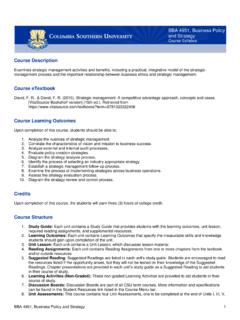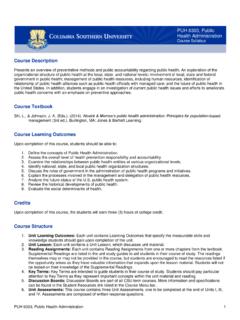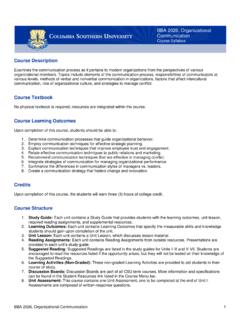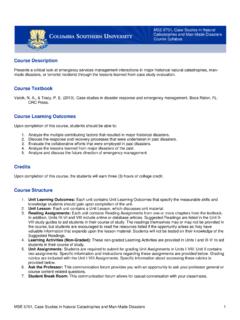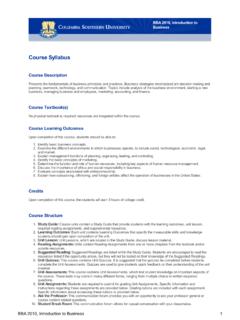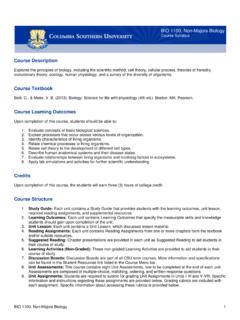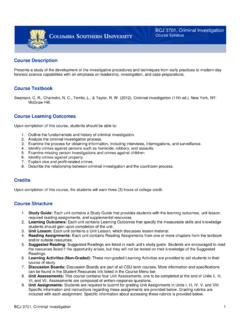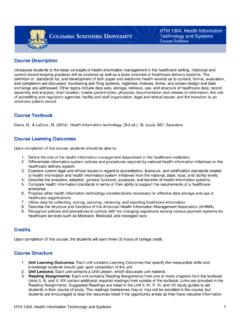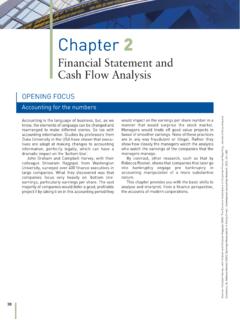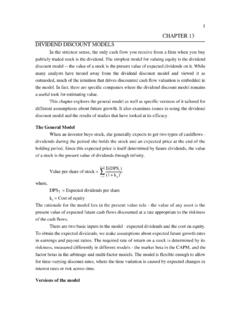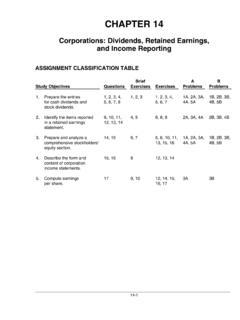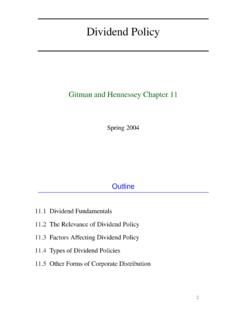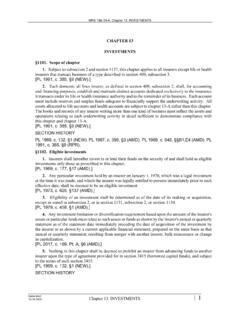Transcription of Chapter 17 Payout Policy - online.columbiasouthern.edu
1 Copyright 2011 Pearson Prentice Hall. All rights reserved. Chapter 17 Payout Policy Copyright 2011 Pearson Prentice Hall. All rights reserved. 17-2 Chapter Outline Distributions to Shareholders Comparison of Dividends and Share Repurchases The Tax Disadvantage of Dividends dividend Capture and Tax Clienteles Payout Versus Retention of Cash Signaling with Payout Policy Stock Dividends, Splits and Spin-offs Copyright 2011 Pearson Prentice Hall. All rights reserved. 17-3 Learning Objectives two ways a company can distribute cash to its shareholders. the dividend payment process and the open-market repurchase process. stock split, reverse stock split, and stock dividend ; describe the effect of those actions on stock price. the effect of dividend payment or share repurchase in a perfect world. Copyright 2011 Pearson Prentice Hall. All rights reserved. 17-4 Learning Objectives (cont'd) perfect capital markets, describe what Modigliani and Miller (1961) found about Payout Policy .
2 The effect of taxes on dividend Policy ; compute the effective dividend tax rate. reasons why firms might accumulate cash balances rather than pay dividends. the effect of agency costs on Payout Policy . the impact of information asymmetry on Payout Policy . Copyright 2011 Pearson Prentice Hall. All rights reserved. 17-5 Distribution to Shareholders Payout Policy The way a firm chooses between the alternative ways to distribute free cash flow to equity holders Copyright 2011 Pearson Prentice Hall. All rights reserved. 17-6 Figure Uses of Free Cash Flow Copyright 2011 Pearson Prentice Hall. All rights reserved. 17-7 Dividends Declaration Date The date on which the board of directors authorizes the payment of a dividend Record Date When a firm pays a dividend , only shareholders on record on this date receive the dividend . Copyright 2011 Pearson Prentice Hall. All rights reserved.
3 17-8 Dividends (cont'd) Ex- dividend Date A date, two days prior to a dividend s record date, on or after which anyone buying the stock will not be eligible for the dividend Payable Date (Distribution Date) A date, generally within a month after the record date, on which a firm mails dividend checks to its registered stockholders Copyright 2011 Pearson Prentice Hall. All rights reserved. 17-9 Figure Important Dates for Microsoft s Special dividend Copyright 2011 Pearson Prentice Hall. All rights reserved. 17-10 Dividends (cont'd) Special dividend A one-time dividend payment a firm makes, which is usually much larger than a regular dividend Stock Split (Stock dividend ) When a company issues a dividend in shares of stock rather than cash to its shareholders Copyright 2011 Pearson Prentice Hall. All rights reserved. 17-11 Figure dividend History for GM Stock, 1983 2008 Copyright 2011 Pearson Prentice Hall.
4 All rights reserved. 17-12 Dividends (cont'd) Return of Capital When a firm, instead of paying dividends out of current earnings (or accumulated retained earnings), pays dividends from other sources, such as paid-in-capital or the liquidation of assets Liquidating dividend A return of capital to shareholders from a business operation that is being terminated Copyright 2011 Pearson Prentice Hall. All rights reserved. 17-13 Share Repurchases An alternative way to pay cash to investors is through a share repurchase or buyback. The firm uses cash to buy shares of its own outstanding stock. Copyright 2011 Pearson Prentice Hall. All rights reserved. 17-14 Share Repurchases (cont'd) Open Market Repurchase When a firm repurchases shares by buying shares in the open market Open market share repurchases represent about 95% of all repurchase transactions. Copyright 2011 Pearson Prentice Hall. All rights reserved.
5 17-15 Share Repurchases (cont'd) Tender Offer A public announcement of an offer to all existing security holders to buy back a specified amount of outstanding securities at a prespecified price (typically set at a 10%-20% premium to the current market price) over a prespecified period of time (usually about 20 days) If shareholders do not tender enough shares, the firm may cancel the offer and no buyback occurs. Copyright 2011 Pearson Prentice Hall. All rights reserved. 17-16 Share Repurchases (cont'd) Dutch Auction A share repurchase method in which the firm lists different prices at which it is prepared to buy shares, and shareholders in turn indicate how many shares they are willing to sell at each price. The firm then pays the lowest price at which it can buy back its desired number of shares Copyright 2011 Pearson Prentice Hall. All rights reserved. 17-17 Share Repurchases (cont'd) Targeted Repurchase When a firm purchases shares directly from a specific shareholder Greenmail When a firm avoids a threat of takeover and removal of its management by a major shareholder by buying out the shareholder, often at a large premium over the current market price Copyright 2011 Pearson Prentice Hall.
6 All rights reserved. 17-18 Comparison of Dividends and Share Repurchases Consider Genron Corporation. The firm s board is meeting to decide how to pay out $20 million in excess cash to shareholders. Genron has no debt, its equity cost of capital equals its unlevered cost of capital of 12%. Copyright 2011 Pearson Prentice Hall. All rights reserved. 17-19 Alternative Policy 1: Pay dividend with Excess Cash With 10 million shares outstanding, Genron will be able to pay a $2 dividend immediately. The firm expects to generate future free cash flows of $48 million per year, thus it anticipates paying a dividend of $ per share each year thereafter. Copyright 2011 Pearson Prentice Hall. All rights reserved. 17-20 Alternative Policy 1: Pay dividend with Excess Cash (cont'd) Cum- dividend When a stock trades before the ex- dividend date, entitling anyone who buys the stock to the dividend The cum- dividend price of Genron will be Current dividend (Future Dividends) 2 2 40 $ Copyright 2011 Pearson Prentice Hall.
7 All rights reserved. 17-21 Alternative Policy 1: Pay dividend with Excess Cash (cont'd) After the ex- dividend date, new buyers will not receive the current dividend and the share price and the price of Genron will be (Future Dividends) $ Copyright 2011 Pearson Prentice Hall. All rights reserved. 17-22 Alternative Policy 1: Pay dividend with Excess Cash (cont'd) Copyright 2011 Pearson Prentice Hall. All rights reserved. 17-23 Alternative Policy 1: Pay dividend with Excess Cash (cont'd) In a perfect capital market, when a dividend is paid, the share price drops by the amount of the dividend when the stock begins to trade ex- dividend . Copyright 2011 Pearson Prentice Hall. All rights reserved. 17-24 Alternative Policy 2: Share Repurchase (No dividend ) Suppose that instead of paying a dividend this year, Genron uses the $20 million to repurchase its shares on the open market. With an initial share price of $42, Genron will repurchase 476,000 shares.
8 $20 million $42 per share = million shares This will leave only million shares outstanding. 10 million million = million Copyright 2011 Pearson Prentice Hall. All rights reserved. 17-25 Alternative Policy 2: Share Repurchase (No dividend ) (cont'd) The net effect is that the share price remains unchanged. Copyright 2011 Pearson Prentice Hall. All rights reserved. 17-26 Alternative Policy 2: Share Repurchase (No dividend ) (cont'd) Genron s Future Dividends It should not be surprising that the repurchase had not effect on the stock price. After the repurchase, the future dividend would rise to $ per share. $48 million million shares = $ per share Genron s share price is $ Copyright 2011 Pearson Prentice Hall. All rights reserved. 17-27 Alternative Policy 2: Share Repurchase (No dividend ) (cont'd) Genron s Future Dividends In perfect capital markets, an open market share repurchase has no effect on the stock price, and the stock price is the same as the cum- dividend price if a dividend were paid instead.
9 Copyright 2011 Pearson Prentice Hall. All rights reserved. 17-28 Alternative Policy 2: Share Repurchase (No dividend ) (cont'd) Investor Preferences In perfect capital markets, investors are indifferent between the firm distributing funds via dividends or share repurchases. By reinvesting dividends or selling shares, they can replicate either Payout method on their own. Copyright 2011 Pearson Prentice Hall. All rights reserved. 17-29 Alternative Policy 2: Share Repurchase (No dividend ) (cont'd) Investor Preferences In the case of Genron, if the firm repurchases shares and the investor wants cash, the investor can raise cash by selling shares. This is called a homemade dividend . If the firm pays a dividend and the investor would prefer stock, they can use the dividend to purchase additional shares. Copyright 2011 Pearson Prentice Hall. All rights reserved. 17-30 Textbook Example Copyright 2011 Pearson Prentice Hall.
10 All rights reserved. 17-31 Textbook Example (cont'd) Copyright 2011 Pearson Prentice Hall. All rights reserved. 17-32 Alternative Policy 3: High dividend (Equity Issue) Suppose Genron wants to pay dividend larger than $2 per share right now, but it only has $20 million in cash today. Thus, Genron needs an additional $28 million to pay the larger dividend now. To do this, the firm decides to raise the cash by selling new shares. Copyright 2011 Pearson Prentice Hall. All rights reserved. 17-33 Alternative Policy 3: High dividend (Equity Issue) (cont'd) Given a current share price of $42, Genron could raise $28 million by selling million shares. $28 million $42 per share = million shares This will increase the total number of shares to million. Copyright 2011 Pearson Prentice Hall. All rights reserved. 17-34 Alternative Policy 3: High dividend (Equity Issue) (cont'd) The new dividend per share will be And the cum- dividend share price will be Again, the share value is unchanged.
